What heating batteries are best for an apartment: classification of radiators and their features
Some consider the centralized heat supply in apartment buildings to be a relic of the Soviet era, while others consider it to be an undoubted benefit of civilization. But we all continue to use this heating method.
The main element of such a system is the heating batteries for the apartment, which stand under the window in the living rooms of apartment buildings. Their types and features will be discussed in our article. We will also briefly consider the main advantages and disadvantages of cast iron, aluminum, steel and bimetal radiators.
The content of the article:
The principles of classification of radiators for apartments
As a heat carrier in centralized heating systems, water heated to 95 ° C is usually used. Moreover, it is used not purified distilled, but technical with dissolved salts and additives.
As a result, the material from which the battery is made in the apartment must for a long time calmly endure the effects of both temperature drops and moisture, and the impurities contained in the coolant.
To last for many years, the battery for heating the apartment must:
- withstand operating pressure up to 9 atm (ideally up to 12-15 atm);
- made of metals resistant to chemical and electrochemical corrosion;
- have high heat dissipation.
Pressure in apartment radiators fluctuates around 4–7 atm. Much here depends on the number of storeys of the apartment building, the temperature outside the window and the operating conditions of the heating system. But when crimping andwater hammer pressure can briefly rise to 15 atm and above.
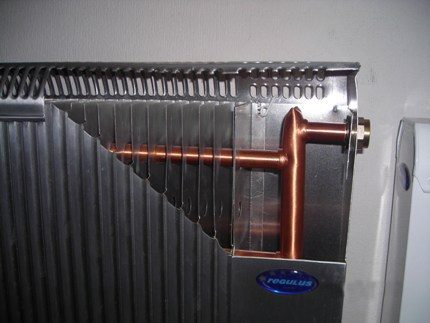
Also, the heating device in question should be easy to install, have a presentable appearance and low cost. But, most importantly, it must have excellent heat transfer characteristics.
The main task of the radiator - give the room the heat that came through pipes with water. The more efficiently he does it, the better the landlord.
There are two main criteria for classifying heating batteries:
- The material of manufacture.
- Constructive execution.
All other parameters are already technical characteristics of a specific radiator model.
Features of different designs
The functionality of heating radiators is influenced not only by the material from which they are made, but also by their design.
So, constructively, batteries are:
- sectional (block);
- columnar (tubular);
- panel.
The first two options are a set of several elements assembled into a single heater, and the third is a monolithic block.
Sectional devices for water heating include widespread aluminum radiators. A classic example of a columnar analogue is an old cast-iron battery.
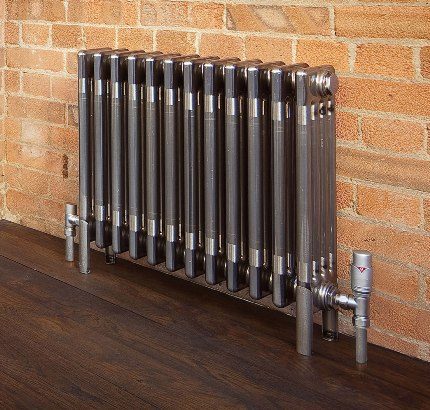
Sectional radiator consists of two collectors interconnected by plate blocks of metal. Water in it does not move along these jumpers. The heat transfer medium first gives off a pair of pipes, and they already heat sections with ribs.
In a column heating device, jumper blocks, on the contrary, have internal cavities for water circulation. A panel is generally a completely hollow single unit.
Separation by material
In terms of battery design, there are vertical and horizontal. For apartments, the second option is usually selected - they are easier to install under the window and connect to the pipes of the existing heating system.
But if there is an acute desire, then it is quite possible to install a vertical type. Only such installation is more complicated and more expensive.
However, all this is more a question of aesthetics and personal preferences of the landlord in the issue of interior design. The main point of choosing a household heating radiator is the metal of its manufacture. It can be cast iron, steel, aluminum or bimetal (aluminum + steel).
Each metal has its own merits. To determine exactly which radiator is best for a particular apartment, you need to carefully study all the features of the available options.
In some cases, the best choice would be a cast-iron battery, while in others, only a steel analog will be suitable for installation.
Option # 1 - Corrosion Resistant Cast Iron
The cast-iron batteries remaining in some apartments from Soviet times now look ugly, and sometimes openly ugly. This is especially true for appliances with a large number of layers of partially peeling paint.
Initially, cast iron, as a material for the production of radiators, was chosen because of the cheapness of the metal and the simplicity of mass production of devices for heating.
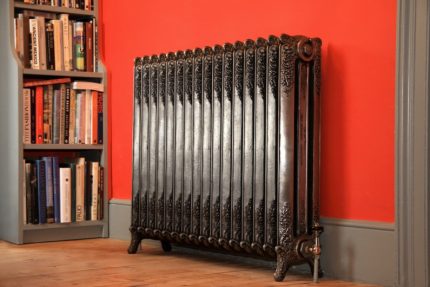
Such batteries continue to heat many apartments today, even half a century after installation. This is the best choice among all analogues for resistance to corrosion.
Plus, blockages and air blockages in such heaters are formed only in extremely rare cases. The gaps in their internal cavities are initially too large for suspensions and air bubbles in the coolant.
Among the main advantages of cast iron it is worth highlighting:
- long service life;
- resistance to corrosion processes;
- low price;
- high thermal inertness;
- unpretentiousness in terms of purity of water.
Their main advantage and at the same time a disadvantage is the inertness of heating and cooling.On the one hand, a cast iron radiator slowly heats up, but on the other hand it does not cool down as fast as aluminum or steel.
Moreover, a sufficiently large volume of water is contained inside it. In a situation of temporary shutdown of central heating and termination of the coolant circulation, the cast-iron battery will still gradually give off heat. Whereas other options, on the contrary, instantly cool.
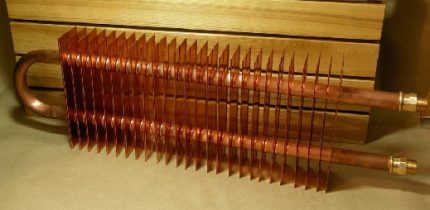
Among the shortcomings of cast-iron appliances are:
- heavy weight - one section weighs 5-6 kg;
- low protection againstwater hammer;
- brittleness of cast iron - such a battery, split from frozen inside the water, is far from rare;
- point strike - predisposition to damage during point mechanical shocks.
Another significant drawback of cast iron is the relatively low working pressure of 6–8 atm. For apartments in old panel five-story buildings orstalin this option is quite suitable. But for a dwelling in a modern apartment building in 12-16 floors, it is better to prefer something else.
At a minimum, before buying a cast-iron battery for installation in a high-rise building, it is necessary to clarify the coolant pressure existing in its heating system, usually there it is above 10 atm.
More about the pros and cons of cast iron batteries we wrote in next article.
Option # 2 - Practical Steel
Steel batteries are practical and come in two types - tubular or panel. The first are a direct analogue of the cast iron appliances described above. They have similar characteristics on heat transfer and weight, but more presentable appearance.
The second are made of two steel sheets welded together and forming inside a thin layer-cavity for water circulation.
This option has higher heat transfer rates, so they are often combined together in several pieces. As a result, the total heat transfer area increases dramatically.
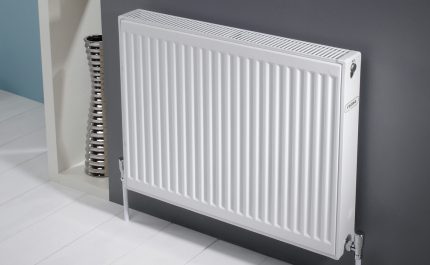
Steel batteries survive betterwater hammerthan analogues of cast iron. But they have one very weak spot - welds. Here, rusting most often begins, and here, mainly, breaks occur during jumps in the pressure of water in the system.
The advantages of steel radiators are as follows:
- Low inertness - heats up quickly and quickly transfers heat to the room.
- Light weight - with the same heat dissipation, a steel device weighs obviously less than a cast-iron one.
- Low cost.
- The ability to install a thermostat.
- Attractive and often original design.
As for the negative points, they are also available. So, these radiators should definitely not be installed in bathrooms. There is high humidity at which steel will quickly rust. In such conditions, the steel battery will not last long.
For apartments in high-rise buildings, it is not recommended to take steel radiators. They are more suitable for installation in private homes with a lower working pressure of the coolant than in a central heating system. More information on pressure standards and ways to increase it is given. here.
Option # 3 - Durable Aluminum
Aluminum radiators are today the most common in the market of household heating equipment. This is due to their low cost, durability and light weight, as well as the extreme ease of installation.

When casting, separate sections are created, which are then connected into a common radiator by a set of several of these blocks. If necessary, such a battery can be increased by adding new elements even after installation is complete.
Extrusion the analogue is immediately made at the factory. Add to it the details to increase the area of heat transfer then impossible. But it is cheaper than the injection option.
Performance characteristics and installation features of aluminum radiators, we examined in detail in another our article.
Among the advantages of aluminum radiators, it is worth highlighting:
- high heat transfer rates;
- low weight of the heater;
- modern design;
- affordable cost;
- the ability to complete thermostat;
- service life of 30 years;
- lack of predisposition to peeling paint.
The main disadvantage of an aluminum heater is the demanding characteristics of the coolant. The smallest solid suspensions during the circulation of water begin to scratch the protective coating inside. As a result, aluminum remains unprotected and begins to graduallyto corrode.
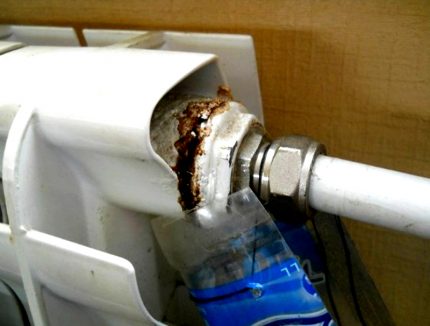
Another rather unpleasant moment is the formation and accumulation of hydrogen in aluminum radiators. If these batteries are not equippedair vents, then they can be slightly inflated from the inside.
Breaking the heater will not break, but small leaks may well form at the junction points. Plus increases the chance of education air congestion in the system, what is called plus or advantage is also difficult.
The maximum working pressure for different models of aluminum radiators ranges from 10–20 atm.
In this indicator, they are superior to cast iron and steel counterparts, but inferior to bimetallic competitors. It is this option that is recommended in most cases to be installed in city apartments.
Option # 4 - practical bimetal
The most durable and durable among all household heating radiators are bimetallic. They have a steel core through which water circulates, and an aluminum outer layer. As a result, they combine the reliability of steel and the heat transfer of aluminum.
We recommend the existing varieties of bimetallic batteries, their characteristics and selection rules. read here.

These batteries were originally created to replace old cast iron. They were immediately designed taking into account the specifics of the existing district heating in Russia.
No wonder they are called universal radiators, which can be installed without problems in almost any apartment.
The advantages of a bimetal radiator are as follows:
- Reliability - working pressure in the region of 35 atm.
- Undemanding to the chemical composition of the coolant.
- High corrosion resistance.
- Compactness and modern appearance of the device.
- Light weight.
The main and only significant disadvantage of this device is the high price. They are the most expensive among all analogues. However, these costs are required.overlap long service life and the absence of leaks with floods.
Especially bimetallic radiators are relevant in homes where frequent pressure drops in the heating system occur.
Conclusions and useful video on the topic
To make it easier for you to figure out which radiator is better, we made a selection of video materials with an analysis of the different nuances of these devices.
The following video will help you sort out the types of radiators and determine which are best suited for specific operating conditions:
10 mistakes when replacing old heating batteries in an apartment:
Expert advice on choosing the best heating radiator in the following video:
When choosing which battery to put in your apartment, you must first focus on the parameters of the central heating system.
In an old house, it is often possible to install only cast-iron radiators. Aluminum options are ideal for new buildings and panel five-story buildings. And reliable bimetallic analogs are universal devices suitable in almost any situation, but worth a lot.
And which batteries do you personally consider the best and which ones are installed in the heating circuit of your house / apartment? Share your impressions of their use, add unique photos of your radiators and useful recommendations to beginners.

 How and what is better to close the heating battery: options for masking radiators
How and what is better to close the heating battery: options for masking radiators 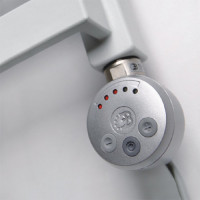 Heating elements for heating radiators: purpose, types, selection criteria, connection features
Heating elements for heating radiators: purpose, types, selection criteria, connection features 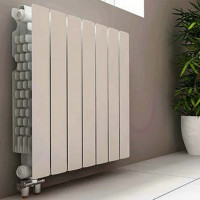 How to choose heating radiators for an apartment and a private house: selection criteria and advice to customers
How to choose heating radiators for an apartment and a private house: selection criteria and advice to customers 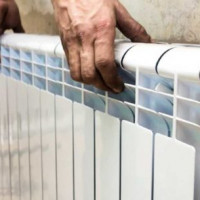 Replacing heating radiators: a guide for dismantling old batteries and installing new appliances
Replacing heating radiators: a guide for dismantling old batteries and installing new appliances 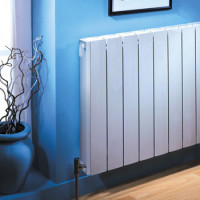 Wiring diagrams for radiators: an overview of the best ways
Wiring diagrams for radiators: an overview of the best ways  How much does it cost to connect gas to a private house: the price of organizing gas supply
How much does it cost to connect gas to a private house: the price of organizing gas supply  The best washing machines with dryer: model rating and customer tips
The best washing machines with dryer: model rating and customer tips  What is the color temperature of light and the nuances of choosing the temperature of the lamps to suit your needs
What is the color temperature of light and the nuances of choosing the temperature of the lamps to suit your needs  Replacement of a geyser in an apartment: replacement paperwork + basic norms and requirements
Replacement of a geyser in an apartment: replacement paperwork + basic norms and requirements
Yes, cast iron may not be so reliable. I put in my time new cast-iron batteries of domestic production, and a couple of years ago they began to get wet at the joints between the sections. Such an insidious defect, but at first everything was fine. Well, the avaricious pays twice, in the end I had to install new bimetal radiators. And I live just in the Stalin five-story building, where there are no critical pressure values in the heating system.
If you reason like that, then any material can be considered unreliable. After all, a defect can occur on a cast-iron battery, and on steel, and on bimetallic, and on whatever. It is worth comparing the quality of normal serviceable radiators, well, the price itself.
And then aluminum radiators are noticeably ahead of everyone else, not in vain they are so popular among people.
I read that steel radiators in skyscrapers are not very high quality. I even decided to change those that the builders set (the apartment is new). But when we survived the winter here, I realized that I would not hurry with the replacement.
It turned out that we have such a warm apartment that we turn off all batteries in the winter. The heat that comes from the risers is enough, plus the sunny side.
That's interesting: is it a new house for now or will it continue to be so? Share your experience who has lived in new homes for at least a couple of years. For reference: we have a panel (some new, with external insulation). Windows to the northeast and southeast. Distribution of heating from above.
Good afternoon, Vladimir. It will be so.
I dare to suggest that your apartment is sandwiched between others. By and large, they heat up your property. This is an advantage of non-corner apartments of middle floors.
If it is enough for you to heat some risers, in the future it will be the same, provided that the temperature of the supplied coolant is maintained.
The disadvantage of steel radiators is their service life, in practice it is 10-15 years. After that, leaks appear. If the appearance is combined with the interior of the rooms, then there is no need to rush with the replacement.
The developer, it seems, did not violate building codes for thermal insulation of walls, and installed high-quality metal-plastic windows. You can only be congratulated on a successfully purchased apartment.